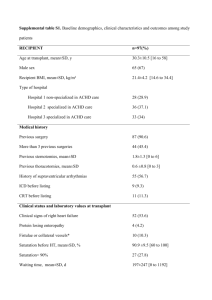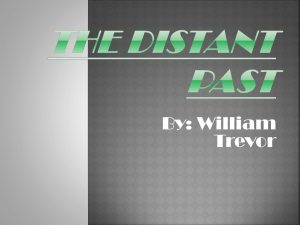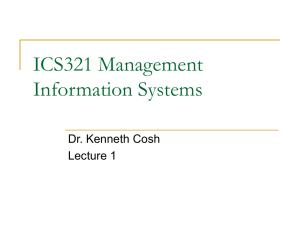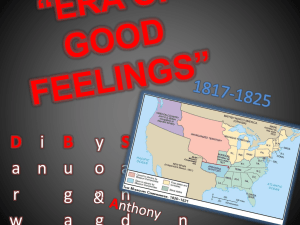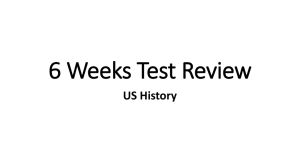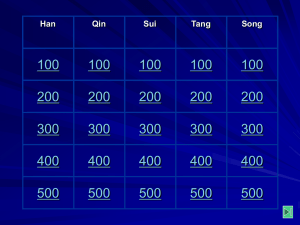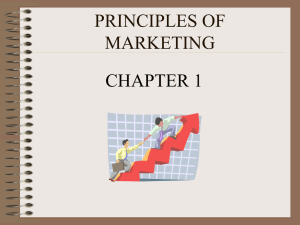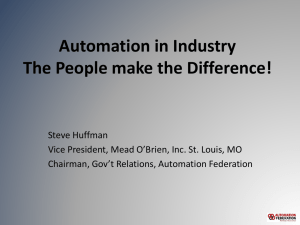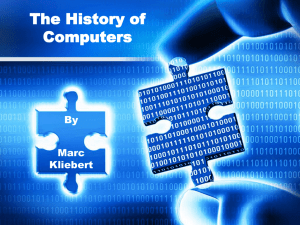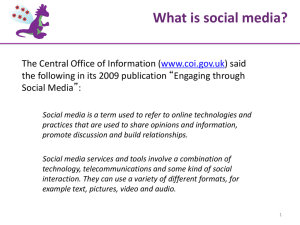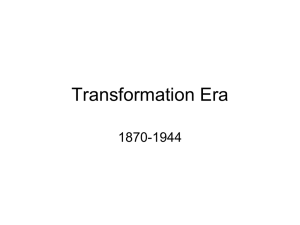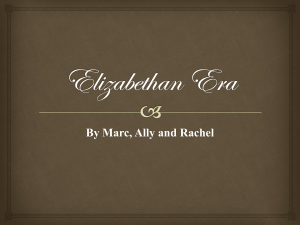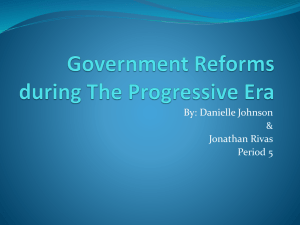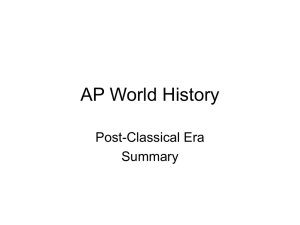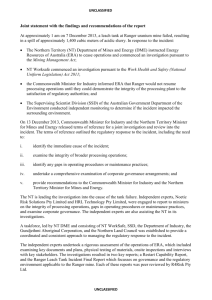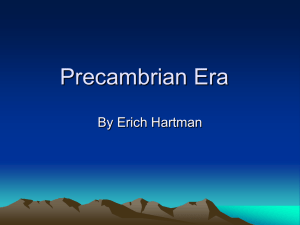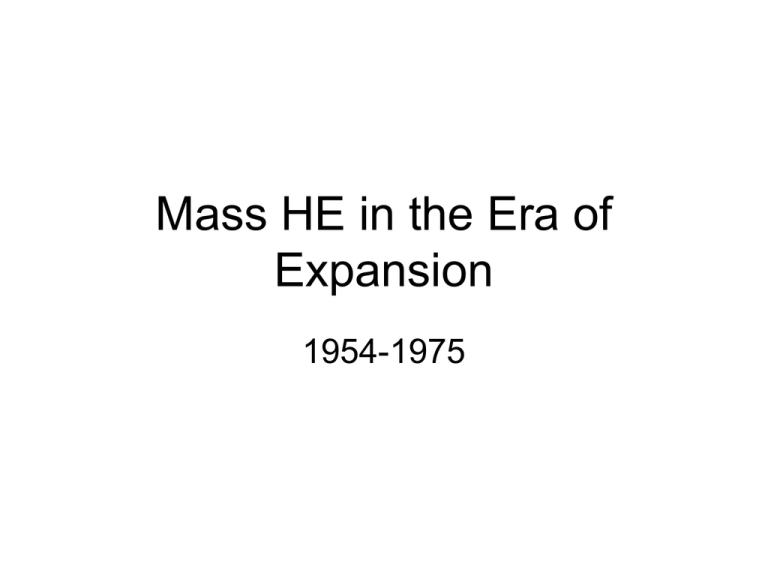
Mass HE in the Era of
Expansion
1954-1975
Portrait of American HE 1700 & 1975
US Population
Student enrolled
Number of faculty
Number of Institutions
Degrees conferred
1700
250,000
150
5
2
15
1975
215,465,000
11,185,000
628,000
3,026
1,665,533
Era of Mass HE
• HE and War
–
–
–
–
Restricted research radar, bombs, planes, gases
Returning veterans
GI Bill; Subsidizing home loans
Changing nature of work: losing manufacturing jobs, rise of unions,
advent of professional and technical work
• Beginnings of Civil Rights Movement
–
–
–
–
–
–
–
1948: Integration of military
1950 Sweatt v Painter (TX)
1954 Brown v Board of Ed
1956 Hawkins v Board of Control (FL)
1960s Johnson’s civil rights agenda
1972 Title IX
1973 Section 504
Era of Mass HE
• Beginnings of Civil Rights Movement Cont.
• Florida ex rel Hawkins v Board of Control
– 1949: Virgil Hawkins, Bethune Cookman faculty member, applied to U
of Florida law school; he and 5 other Blacks met requirements but
denied admission
– Sup. Ct of Fl: Equal protection clause permits state to pay for education
elsewhere or create law school for Blacks; court later reconsiders,
requires admission of all qualified, but grants delay
– US Sup. Court: “A Negro is entitled to prompt admission to graduate
professional schools…”
– Hawkins withdraws application, graduates from northern law school
– 1959: FL admits 1st Black to law school
• HE Inst. were not taking leadership roles; the federal govt had to
compel
Reaction to Brown Decision
• South
– Conservative launch “righteous crusade against
integration
– Southern Manifesto: Accuse Supreme Court of “clear
abuse of judicial power” Use all lawful means to
reverse decision
– Virginia and Arkansas close public schools for at least
1 yr rather than admit Blacks
– Until 1962 no Black student attended school w/Whites
in MS, SC, or AL
Reaction in HE
“The south stands at Armageddon. The battle is joined.
There is not more difference in compromising the
integrity of race on the playing fields than in the
classroom. One break in the dike and the relentless seas
will rush in and destroy us.”
Georgia Gov Griffin, 1955, when Georgia Tech was to play
a football game against Pittsburgh, a team with Black
players, in bowl game. Tech played.
Era of Mass HE
• HE During This Period
– Institutions grew larger, more were built
• 600 new publicly supported campuses
• The American State University System
– Unique invention and attempts to copy model in other
countries
– “Place a young person could go with little money, work in
a store, get an education, and go out and make a life for
himself”
– Criticisms
» Private schools accused public schools of stealing
students with cheaper students
» Students weren’t ready for university work
• Beginnings of community college movement
Era of Mass HE
– GI Bill; government research; development of
research universities
– 650 private colleges (Half have closed)
– Transition of normal schools
• 1st Teacher Education Institutions where called Normal
schools in Germany
• At first didn’t award degrees
• Began awarding degrees and changed name to Teachers
College or Female Seminaries
– Single sex institutions become co-ed (Notre
Dame/Yale/Harvard)
Era of Mass HE
• Students of the Era
–
–
–
–
–
Growth enrollment by 500% from 1945 to 1975
2 m to 11 m; HE becomes an industry/business
Cohort changes not restricted to 18-22
Access opens, no longer elitist
Financial aid programs provide opportunity
• Faculty of the Era
– Transition from Old-time Professor to New-time
Professor
Expansion into an industry
1970
2,556 colleges/universities
1,665 4 yr
891 2 yr
1980 3,231 colleges/universities
1,957 4 yr
1,274 2 yr
1965 HE Act and financial aid (access)
1970 Task Force of HE
Focus should be on teaching, not research—
beginning of the debate……
External Politics: Sign of the Times
Pre WW II Fear of subversives/non-conformists
1940 Bertrand Russell, mathematician/philosopher
NY Supreme Court unfit to teach because he held
“immoral and salacious doctrines” Role of Einstein; 40
professors fired for refusing to divulge political beliefs.
Wave of intolerance following WW II
1952 Senate Judiciary Committee on Internal Security—
chaired by McCarran “The Communist party of the US
has put forth every effort to infiltrate the teaching
professions…..agents of the Kremlin have been
remarkably successful……enlisted the support of at least
3,500 professors.””
McCarthy: Senate Committee on Gov’t Operations
• Goal: to rid the academy of Communists and Communist thinkers:
“Academic freedom means their right to force you to hire them to
teach your children a philosophy in which you do not believe”
1949 Conant, Harvard president:
Because Communists surrender “intellectual integrity” they are unfit to
discharge the duties of a teacher in this country”
AAUP position: Communist Party was legal; faculty have the right to
affiliate; but Communism requires that the believer give up freedom
so a Communist can not be a free person.
No protection for Communists
Era of Mass HE
• Student Activism
• Prior to 1960s
– Generally peaceful
– JFK idealism, New Frontier
– Assassination leads to disenchantment
• Beginnings of movement toward different prospective
• Feb 1960: 4 Black students (Greensboro, NC)
– Civil Rights: peaceful sit ins, marches, boycotts, reactions, bombings
– Gains support on campuses in the north
– Fund raising, freedom riders, voter registration
• War in Vietnam
–
–
–
–
1965 bombing of N Vietnam
Contain spread of communism in SE Asia
Disheartened/confused public
Defeat was unthinkable, victory seemed impossible
Era of Mass HE
• Campus Reaction to Nation’s Activity
– Interactions of Civil Rights Movement and anti war movement
radicalized students
– Lost faith
– Rallies, protests, marches as expressions
• Events
–
–
–
–
–
–
–
Sept. 1964, Univ. of CA-Berkeley (free speech
movement)
Students suspended: Mario Savio
Vietnam
Faculty-student strikes
Civil disobedience
Birth of the SDS (Students for a Democratic Society)
Birth of the Black Panther Party (Stokely Carmichael, Huey
Newton, Black Pride)
– Malcolm X, Martin Luther King Jr., Robert Kennedy, Watts,
Vietnam
Era of Mass HE
• Events Cont.
– April 1968: Columbia Univ.: Morningside Heights, Black students
seized administration building
– Northwestern, Cornell, San Francisco State – demands for Black
Studies, Ethnic Studies programs, access for Black students
– 1968: Democratic convention in Chicago
Rejection of middle class values, war in the streets
– Issues: local and national
• War & draft; civil rights; investments in S. Africa; free speech; dorm
visitation; in loco parentis; impersonal education-absent faculty;
admissions of minorities; scholarships for minorities; recruitment of
students by military/war industries; contracts between universities
and defense contractors; ethnic studies programs; sex, drugs, &
rock n roll; etc.
• Student involvement
– Not all campus or all students
– Cohen 1% hard core radical; radicals (rebels) v collegiate
Era of Mass HE
• Events Cont.
• April 30, 1970- Nixon Announces invasion of Cambodia
• Kent State Univ.-Saturday burn ROTC building, National
Guard called out; May 4th (Monday)- Guard fires 60
shots, killing 4 injuring 1
• 10 days later at Jackson State University (HBCU/MS)
150 shots sprayed across the women’s dorm; 2 dead, 14
injured
• Later same summer- bomb in defense related research
center @ Univ. of Wisconsin, kills GA, 4 injured
• Incidents: 1971 about 1,000; 1972 about 500, mid 70s
none
• Student interest turn from sit-ins to grades
Era of Mass HE
• Institutional Responses to Students’ revolts
– Punishment: In loco parentis, civil authorities arrest and
mobilized nonradical students
– Reaffirmation of policy/warnings of consequences (Univ. of Notre
Dame), increased reaction
– Persuasion strategies: Inappropriate activity, personal interaction
– Immediate concession: Caused counter reaction, set stage for
further protests
– Open communications: Agree to consider, avoid using civil
authorities
• 1968 Commission on Civil Disorders
• 1970 Commission on Campus Unrest
• The Strawberry Statements: Notes of a Campus
Revolutionary book & movie
– Chronicle of 1960s demonstration at Columbia
– a Columbia administrator, who deprecated student opinions
about university administrative decisions as having no more
importance than if the students had said they liked the taste of
strawberries”


